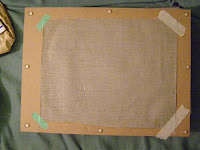The first post I made covered archival storage of art on paper. Now we move onto Canvas. Most of the archival qualities of canvas paintings come with how they're created.
Supports grounds and gessos
Depending on the paint you are using (acrylic or oil) you need a proper surface to paint on that will help keep your painting alive for a long time. In general Linen and Canvas are both fabulous. If you are stretching it over stretcher bars, make sure they're sturdy enough for the size. larger paintings should have gussets, cross braces and heavy duty bars to support them. This will prevent bowing and breakage.
The gesso or ground you use has to be appropriate to the paint you are using. Example, using an oil ground for acrylic paintings could lead to many problems including sagging peeling and rotting depending on the type of ground. Always use an acrylic gesso for acrylics. You can use an acrylic gesso for oil painting as well, but make dang sure its dry, and don't mix it in with oil paint. Oil paint can safely go on top of acrylic but not underneath or mixed in.
For oils use a ground for oil paints. I wont go into them here because gamblin has a fabulous write up here on their products that says more than I could, and says it better.
Be cautious of using surfaces like Masonite that can be oily and highly acidic. Painting on cardboard is also a terrible idea if you want it to last.
Varnishes
Acrylic paint in has a polymer base with pigments added; Its plastic with colour. That alone makes it about more durable than you probably realize. If you've chosen artist quality paints and used light fast colours you're doing great and probably don't even need a varnish. There are a few aesthetic considerations in regards to a finishing layer. Sometimes different pigments will vary the sheen of your work in which case you might want to give it a later of a varnish or a layer that will at least unify your sheen. you can get several products. A plain ol' Acrylic gel medium (polymer medium) with your desired sheen (gloss, matte, semi gloss or satin) makes a great final layer for acrylics. Best of all its the same material that your paints made of, only clear. it will make your bright and dark colours pop if you use a gloss. If you use a matte gel keep in mind the matting agent added to this is not clear. so over dark colours it might look milky.
As always test on something else first.
You can also get some varnishes to block some of that hideous UV that kills colours. Golden Paints has a product called a UVLS varnish. It comes in gloss and matte and blocks UV light from attacking your colours. This is useful if you are selling your piece to make sure the buyer gets the most of the work.
For oil paintings on canvas, you can get many resin and solvent based Varnishes. This gets to be a complicated topic sometimes, but in general I find Gamblin to be the most reliable resource for Oil painters out there. They have a synthetic resin varnish, and many types of damar and mastic varnishes. Damar has a reputation for yellowing over time. Gamvar is a very reputable product for an oil painting varnish. The main thing to look for is "removable" and "non yellowing".
Most varnishes are "removable". This is a frequently misinterpreted word. It's not removable by you, it's removable by conservationists. It means that the people restoring your painting professionally if there is damage or you're 100 years dead and they're restoring it, they remove the varnish layer to fix and restore the painted layer.
For acrylic paintings at least (I've actually not heard of this with oils) you need an isolation coat if you're going to varnish. and Isolation coat is a layer of non removable product applied between your paint and your varnish. I've generally used a polymer medium since its clear and I've used them in the painting anyways. That works well.
Storing
If you do end up with a dent in your canvas, or your canvas looses its tension you can get a product called "canvas tite" that you can apply to the back of your canvas to return some tension. Its best to avoid the problem though.
The other option is pulling the canvas off the stretcher bars and storing it rolled or flat. This is a good option for space saving but requires more care.
You should roll them with tissue paper with the paint side out, to prevent bulking and cracking of the paint, and store them in a tube wrapped in acid free tissue. let it breathe though.
If you store it flat, use the tissue again and store it in a breathable location. a drawer perhaps.
Wood drawers leach acid so be sure to treat the inside to neutralize the effect.
Never trim the edges of a canvas pulled off stretchers. if you ever need to re-stretch the canvas onto bars you need that space to pull and staple. (canvas stretching is for another post).
That's about all I can recall about canvas off the top of my head. Again do research on your own, and check manufacturers websites.















